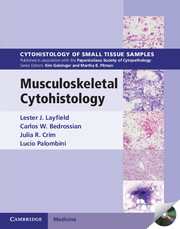Book contents
- Frontmatter
- Contents
- 1 Principles and practice for biopsy diagnosis and management of musculoskeletal lesions
- 2 Ancillary techniques useful in the evaluation and diagnosis of bone and soft tissue neoplasms
- 3 Spindle cell tumors of bone and soft tissue in infants and children
- 4 Spindle cell tumors of the musculoskeletal system characteristically occurring in adults
- 5 Giant cell tumors of the musculoskeletal system
- 6 Myxoid lesions of bone and soft tissue
- 7 Lipomatous tumors
- 8 Vascular tumors of bone and soft tissue
- 9 Pleomorphic sarcomas of bone and soft tissue
- 10 Osseous tumors of bone and soft tissue
- 11 Cartilaginous neoplasms of bone and soft tissue
- 12 Small round cell neoplasms of bone and soft tissue
- 13 Epithelioid and polygonal cell tumors of bone and soft tissue
- 14 Cystic lesions of bone and soft tissue
- Index
4 - Spindle cell tumors of the musculoskeletal system characteristically occurring in adults
Published online by Cambridge University Press: 05 September 2013
- Frontmatter
- Contents
- 1 Principles and practice for biopsy diagnosis and management of musculoskeletal lesions
- 2 Ancillary techniques useful in the evaluation and diagnosis of bone and soft tissue neoplasms
- 3 Spindle cell tumors of bone and soft tissue in infants and children
- 4 Spindle cell tumors of the musculoskeletal system characteristically occurring in adults
- 5 Giant cell tumors of the musculoskeletal system
- 6 Myxoid lesions of bone and soft tissue
- 7 Lipomatous tumors
- 8 Vascular tumors of bone and soft tissue
- 9 Pleomorphic sarcomas of bone and soft tissue
- 10 Osseous tumors of bone and soft tissue
- 11 Cartilaginous neoplasms of bone and soft tissue
- 12 Small round cell neoplasms of bone and soft tissue
- 13 Epithelioid and polygonal cell tumors of bone and soft tissue
- 14 Cystic lesions of bone and soft tissue
- Index
Summary
INTRODUCTION
Spindle cell lesions are numerically the largest category of mesenchymal proliferations occurring in adults and are also the most diagnostically challenging. These lesions vary from benign reactive reparative processes to high grade malignancies including synovial sarcoma, malignant peripheral nerve sheath tumors and some forms of angiosarcoma. These lesions are associated with a significant incidence of both false positive and false negative diagnoses by both cytologic analysis and histologic interpretation of small core biopsies. Unfortunately, ancillary techniques, especially immunohistochemistry are often of little diagnostic aid in separating benign or low grade spindle cell proliferations from fully malignant spindle cell sarcomas. While some spindle cell neoplasms have characteristic age and sites of presentation, these features are of only modest help diagnostically and, in a significant percentage of cases, the cytologic diagnosis will be that of a spindle cell neoplasm followed by a recommendation for surgical biopsy. Cytomorphologic features such as high cellularity, loss of cell cohesion, and nuclear atypia support but do not unequivocally establish the diagnosis of malignancy. Some predominately spindle cell sarcomas can be definitively diagnosed by fine needle aspiration, especially when cell block material is utilized for ancillary studies. Synovial sarcoma, some benign and malignant nerve sheath tumors, and angiosarcomas may have sufficiently characteristic cytomorphology and immunohistochemical or molecular diagnostic profiles to allow definitive diagnosis based on aspirated material. Other lesions including fibrosarcomas, fibromatoses, and smooth muscle neoplasms are associated with insufficiently characteristic morphology to allow definitive diagnosis in the majority of cases.
- Type
- Chapter
- Information
- Musculoskeletal Cytohistology , pp. 41 - 91Publisher: Cambridge University PressPrint publication year: 2000



